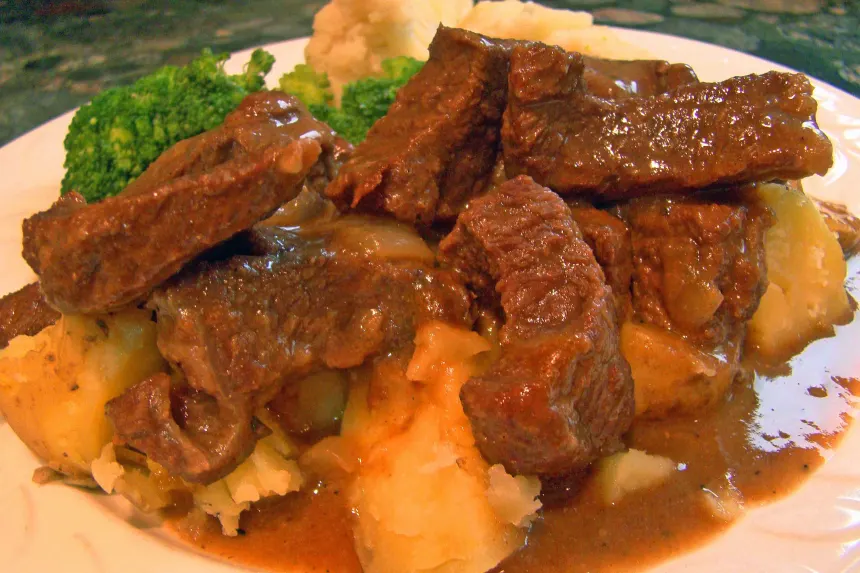Introduction
Adobo Beef with Gravy stands as a testament to the rich culinary heritage of the Philippines, blending tender cuts of beef with the iconic flavors of soy sauce, vinegar, garlic, and aromatic spices. This dish encapsulates the Filipino love for bold, savory, and tangy flavors, and the method of slow simmering ensures the beef becomes melt-in-your-mouth tender while absorbing the complex flavors of the marinade and gravy. Perfectly suited for family dinners, special gatherings, or even meal prepping, this recipe brings the warmth and authenticity of Filipino cuisine directly to your kitchen. As featured on Love With Recipes, this comprehensive guide aims to elevate your cooking experience, offering detailed insights into each step, ingredient nuances, and nutritional considerations to help you craft a dish that’s both delicious and nourishing.
Time
Preparation time including marination: approximately 30 minutes
Cooking time (simmering and gravy making): 1 hour 30 minutes to 2 hours
>Total estimated time: 2 hours to 2 hours 30 minutes
Needed Equipment
- Large heavy-bottomed pot or Dutch oven – essential for slow simmering and flavor development
- Skillet or frying pan – for searing the beef
- Wooden or silicone spatula – for stirring and sautéing
- Measuring spoons and cups – for accuracy in ingredients
- Sharp chef’s knife – for cutting beef and preparing ingredients
- Cutting board – for safe and efficient prep
- Mixing bowls – for marinating
- Fine mesh strainer or slotted spoon – for straining the gravy
- Whisk – for making roux and blending gravy components
- Kitchen towel or paper towels – for drying beef and cleaning
- Storage containers – for leftovers
Tags
Filipino cuisine, Beef dishes, Slow-cooked recipes, Savory gravy, Comfort food, Family-friendly, Authentic flavors, Marinated meat, Traditional recipes, Easy to adapt
Serving Size
Serves approximately 4 to 6 people, depending on portion sizes and accompanying side dishes.
Difficulty Level
Intermediate – requires good knife skills, understanding of simmering techniques, and some experience with making roux and gravy.
Allergen Information
- Soy: Contains soy sauce
- Garlic: Contains garlic
- Possible traces of gluten if soy sauce contains wheat (opt for gluten-free soy sauce if necessary)
Dietary Preference
This dish is not vegan or vegetarian; it is rich in animal protein and contains soy and gluten (if using standard soy sauce). Adaptations are possible for specific dietary restrictions, such as gluten-free soy sauce or low-sodium variants.
Course
Main Course
Cuisine
Filipino
Ingredients
Ingredients in Tables
| Ingredient | Quantity | Notes |
|---|---|---|
| Beef chuck or sirloin, cut into chunks | 2 pounds (900 grams) | Choose well-marbled, tender cuts for best flavor |
| Garlic cloves, minced or crushed | 8-10 cloves | Fresh garlic yields the best flavor |
| Soy sauce (regular or gluten-free) | ½ cup (120 ml) | Adjust to taste for saltiness |
| Vinegar (white cane or coconut vinegar) | ½ cup (120 ml) | Authentic flavor, can substitute with apple cider vinegar |
| Bay leaves | 3-4 leaves | Fresh or dried |
| Black peppercorns | 1 teaspoon | Whole peppercorns for infusion |
| Cooking oil (vegetable, canola, or peanut oil) | 2 tablespoons | For searing and sautéing |
| All-purpose flour (for gravy) | 2-3 tablespoons | Adjust for desired gravy thickness |
| Water or beef broth | 2-3 cups (480-720 ml) | Used during simmering and gravy making |
| Salt and additional pepper (to taste) | As needed | Season according to preference |
Instructions
Step 1: Marinate the Beef
Begin by preparing a flavorful marinade that will tenderize and infuse the beef with key Filipino flavors. In a large mixing bowl, combine the soy sauce, vinegar, minced garlic, bay leaves, and whole peppercorns. Mix thoroughly to ensure all ingredients are well incorporated. Add the beef chunks to the marinade, ensuring each piece is coated evenly. Cover the bowl with plastic wrap or a lid and allow the beef to marinate in the refrigerator for at least 30 minutes. For the best results, marinate for 4 hours or overnight, which allows the flavors to deeply penetrate the meat, resulting in a more complex and tender final dish.
Step 2: Sear the Beef
Once marination is complete, remove the beef from the refrigerator and drain excess marinade, reserving it for later use. Pat the beef dry with paper towels to remove excess moisture; this step ensures proper browning. Heat the cooking oil in a large heavy-bottomed pot or Dutch oven over medium-high heat. When the oil is hot, carefully add the beef chunks in batches if necessary to avoid overcrowding, which can cause steaming instead of searing. Sear each side until they develop a rich, brown crust—about 3-4 minutes per batch. Searing enhances the flavor by creating Maillard reactions, which contribute to the savory depth of the dish.
Step 3: Simmer with the Marinade
Add the reserved marinade to the pot with the seared beef. Pour in enough water or beef broth to cover the meat completely, typically about 2 cups (480 ml). Bring the mixture to a boil over high heat, then reduce the heat to low to maintain a gentle simmer. Cover the pot with a lid, leaving a slight vent for steam to escape. Allow the beef to simmer slowly for 1.5 to 2 hours, stirring occasionally to prevent sticking. During this process, the beef becomes tender and absorbs the flavors of the marinade, vinegar, garlic, and spices. Skim off any foam or excess fat that rises to the surface to keep the broth clear and flavorful.
Step 4: Make the Gravy
Once the beef is tender, carefully remove it from the pot and set aside. To create a rich gravy, prepare a roux by adding 2-3 tablespoons of flour to a small skillet or directly into the pot if suitable. Warm a tablespoon of oil over medium heat, then whisk in the flour, stirring constantly to cook out the raw flour taste—about 2-3 minutes until it turns a light golden color. Gradually add the cooking liquid from the simmered beef, pouring it in small amounts while whisking vigorously to prevent lumps. Continue whisking until the gravy thickens to your desired consistency. Taste and adjust seasoning with salt and pepper as needed.
Step 5: Combine and Finish
Return the cooked beef to the pot with the thickened gravy. Stir well to coat all pieces evenly and allow to simmer for an additional 5-10 minutes. This final step melds the flavors and ensures the beef absorbs the gravy’s richness, resulting in a harmonious dish. Serve hot, garnished with extra bay leaves or freshly chopped herbs if desired.
Preparation Tips
- Marination duration: For maximum flavor and tenderness, marinate the beef overnight. If short on time, at least 30 minutes will impart some flavor.
- Choosing beef cuts: Opt for well-marbled cuts like chuck or brisket for tenderness. Leaner cuts may require less cooking time to prevent dryness.
- Sealing flavor: Always pat beef dry before searing to ensure a good crust formation rather than steaming.
- Controlling acidity: Adjust vinegar quantity based on preference; more vinegar lends a tangier profile, less results in a milder flavor.
- Gravy consistency: Adjust flour amount or add more liquid to achieve your preferred thickness.
Nutritional Information
| Nutrient | Per Serving (approximate) |
|---|---|
| Calories | 350-400 kcal |
| Protein | 25-30 grams |
| Fat | 20-25 grams |
| Carbohydrates | 10-15 grams |
| Sugar | 2-4 grams |
| Sodium | 800-1000 mg |
| Fiber | 1-2 grams |
Tips and Tricks
- Flavor enhancement: Add a splash of calamansi or lemon juice at the end for a citrusy brightness that balances the vinegar’s tang.
- Spice it up: Incorporate a small amount of chili flakes or sliced red chili for heat.
- Vegetable additions: Include potatoes, carrots, or bell peppers during the last 30 minutes of simmering for a more hearty meal.
- Slow cooking: For even more tender beef, use a slow cooker on low for 4-6 hours after searing.
- Leftover flavors: The dish tastes even better the next day as flavors meld, making it ideal for make-ahead meals.
Add-ons
- Hard-boiled eggs simmered in the sauce for added richness
- Fresh herbs like cilantro or green onions for garnish
- Spicy chili oil or vinegar for extra heat
Side Dishes
- Steamed jasmine rice or garlic fried rice
- Pickled vegetables or Filipino ensaladang mangga (green mango salad)
- Steamed vegetables like bok choy or broccoli
- Pan-fried plantains or sweet potatoes for contrast
Improvements
- Use homemade or high-quality soy sauce for richer flavor
- Incorporate aromatics like ginger or onion for additional depth
- Experiment with different vinegars—such as apple cider or rice vinegar—for nuanced acidity
- Adjust cooking times based on beef cut for optimal tenderness
Save and Store
Allow leftovers to cool completely before transferring to airtight containers. Store in the refrigerator for up to 3 days. To reheat, gently warm in a saucepan over low heat or in the microwave until steaming hot. For longer storage, freeze in portions for up to 3 months. To reheat from frozen, thaw in the refrigerator overnight and reheat thoroughly.
FAQ
Can I make this dish vegetarian?
While traditional Adobo Beef with Gravy relies on beef, you can substitute with hearty vegetables like jackfruit, mushrooms, or tofu. Use veggie broth instead of water, and marinate vegetables in soy sauce and vinegar for an authentic flavor.
How can I reduce the sodium content?
Opt for low-sodium soy sauce and reduce the amount of added salt. You can also increase the vinegar and spices to compensate for flavor without extra salt.
What is the best cut of beef for this recipe?
Chuck, brisket, or sirloin are ideal because they become tender with slow cooking and absorb flavors well. Avoid overly lean cuts that may dry out during simmering.
Is it necessary to marinate overnight?
No, but marinating for at least 30 minutes enhances flavor penetration and tenderness. Overnight marination yields a more profound taste and softer meat.
Conclusion
Adobo Beef with Gravy exemplifies Filipino culinary artistry—balancing bold flavors with tender, slow-cooked meat. Its versatility allows for creative variations and adaptations to suit dietary needs and personal preferences. This dish, with its rich history and comforting appeal, is a perfect choice for those eager to explore authentic Filipino cuisine or to bring a taste of the Philippines into their own homes. Remember, the key to a perfect adobo lies in patience—allowing time for flavors to meld, and love to infuse every bite. For detailed recipes, tips, and community sharing, Love With Recipes remains your trusted platform to celebrate culinary diversity and delicious storytelling through food.
References
- Reyes, A. (2012). Filipino Food: The History and the Flavors. Manila: Anvil Publishing.
- Smith, J. (2018). The Art of Filipino Cooking. Food & Wine Magazine.




